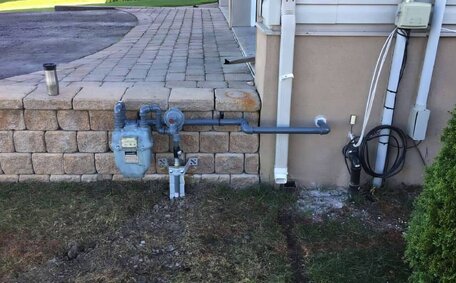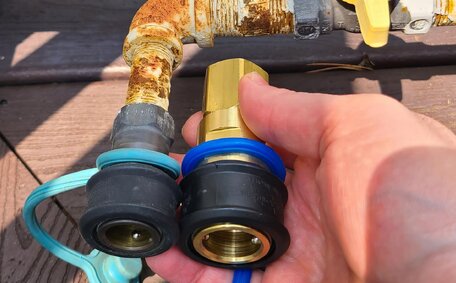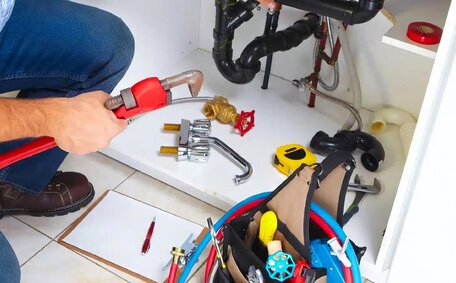What is Trenchless Relining?
Trenchless relining modernises plumbing repairs by eliminating the need for extensive excavation. It involves sending a flexible lining material coated with epoxy resin into existing pipes through small access points.
Once in place, the epoxy resin cures through the application of hot water or steam, creating a robust bond to the existing pipe interior.
Two primary forms of trenchless relining are prevalent:
- Cured-in-place pipe (CIPP) lining: A felt tube soaked in epoxy resin is inverted or pulled into the damaged pipe and inflated to form a tight fit. The resin then cures to harden the liner.
- Epoxy pipe lining: An epoxy coating is brushed or sprayed directly onto the inside of the pipe and cured to form a smooth, seamless new pipe wall.
Offering economic, durability, and environmental advantages, trenchless relining is superior to conventional pipe replacement, characterised by less invasiveness and the avoidance of excavation. It can repair pipes without destroying landscaping or flooring and prevents further root intrusion.
Benefits of Trenchless Pipe Relining
The advantages of trenchless relining versus traditional methods encompass:
- Minimal disruption: Relining negates the use of hefty equipment and excavation, protecting infrastructure and landscaping.
- Cost savings: Relining typically costs between 50% to 70% less than full pipe replacement.
- Enhanced durability: The seamless epoxy barrier coating prevents future root intrusion and protects pipes for decades.
- Eco-friendly process: With less excavation waste and material usage, trenchless relining is better for the environment.
- Preserves structural integrity: Leaving existing pipes intact prevents ground sinkage or foundations damage.
- Faster repairs: Curing the epoxy resin lining takes just 2-4 hours, allowing pipes to quickly resume function.
Opting for trenchless relining can equate to significant savings and minimal disruption for property owners. Offering durable repair outcomes, this innovative method is both eco-conscious and efficient.
Cost Savings
When it comes to pipe repairs, choosing drain pipe relining over traditional pipe replacement methods can result in major cost savings.
Relining methods typically run 50-70% cheaper than traditional sewer line replacements. Residential sewer repairs via trenchless relining may cost near $3,000, as opposed to over $10,000 for total replacements.
Specific cost differences include:
- No heavy equipment rentals or excavation fees
- Minimal labour required
- Shorter project timeframe
- Avoiding landscaping, driveway, or flooring replacement expenses
Beyond initial cost benefits, the extended lifespan of relined pipes further drives long-term savings. With an expected service life of 50+ years, property owners can avoid the need for recurring pipe repairs or replacement projects.
Trenchless relining is a cost-effective method, revitalising pipes at significantly reduced expenses.
Minimal Disruption
One of the biggest advantages of trenchless relining over traditional pipe replacement is the minimal disruption it causes. Since no heavy machinery is required and there is no need for major excavation, trenchless relining avoids destruction to landscaping, driveways, flooring, and other infrastructure.
Conventional procedures employ jackhammers and backhoes, potentially damaging lawns and necessitating trenching.
Traditional methods may extensively damage garden beds, trees, and walls. Pipes beneath driveways would demand tearing up and subsequent repaving of the driveway. Trenchless relining eliminates this destruction by accessing pipes through small openings.
Relining also eradicates long-term disruptions from open trenches on your property. This substantially reduces the project timeline and associated property downtime compared to traditional techniques.
Even for sizable sewer pipes, access points are a mere 20-30 centimetres wide, enabling experienced teams to perform a typical residential relining within a day.
Trenchless relining maintains infrastructure and landscape integrity, averting additional repair or replacement costs. Trenchless relining is innovative and advantageous for property owners, enabling rapid, non-intrusive pipe restoration.
The Trenchless Relining Process
Inspection
The first step is a thorough inspection of the damaged pipes using a remote-operated CCTV camera. The camera is fed through the pipe to identify any faults or issues. The footage also allows technicians to measure the exact pipe length and diameter to fabricate a custom-fitted liner.
Cleaning
The current pipe is thoroughly cleaned with high-pressure water jets to secure an effective bond for the relining. This removes any built-up deposits, grease, intruding roots, or debris to ensure proper liner bonding.
Lining Insertion
The lining, made of felt tubing or coated in epoxy, is saturated with resin and navigated through the pipe by air pressure. The lining material extends the full length of the pipe segment being repaired.
Curing & Finishing
Hot water or steam circulation solidifies the resin-imbued liner within the pipe. As it hardens, the liner bonds to the old pipe walls. Once fully cured, the ends are trimmed and any access points restored.
Specialised tools and professional expertise ensure the relining process is minimally disruptive.
Is Trenchless Relining Right for Me?
When faced with drain or sewer issues, property owners must decide whether traditional excavation methods or trenchless relining is the best repair approach. There are several key factors to consider when assessing if trenchless relining is right for your situation.
Pipe Material and Condition
Trenchless relining is compatible with most pipe materials like concrete, PVC, vitrified clay, and cast iron. The existing drain pipe must be structurally sound enough to withstand the pressures of drain relining. Severely damaged pipes with breaches, cracks, or widespread corrosion may still require replacing.
A thorough CCTV pipe inspection shows the exact extent and location of damage. Minor damage can be repaired by spot repairs or partial relining while pipes in good overall condition can undergo whole-line relining.
Pipe Location and Access
The location and accessibility of the pipe also determines if trenchless relining is possible. Straight pipe segments are easiest to reline while severely offset, low gradient, or complex multi-bend pipes can pose challenges.
Adequate accessibility is crucial; for sewer lines, existing cleanouts or manholes are required as entry points.
Cost Considerations
Generally, trenchless relining offers significant cost-efficiency over complete replacement. But certain complex situations with long inaccessible pipe lengths or severely deteriorated pipes may tip the scales towards traditional pipe laying being more financially viable.
A professional plumbing inspection and quote outlining all options will clarify the best value solution for your property.
For expert advice on trenchless relining’s suitability for your pipes, reach out to Marsfield Plumbing.
When to Choose Traditional Replacement
While trenchless relining is suitable for most residential pipe issues, there are some situations where full pipe replacement is necessary:
Complete Pipe Collapse
If pipes have completely caved in or collapsed, Collapsed pipes negate liner insertion, therefore, relining becomes infeasible. Fully destroyed pipes with severe breaches need excavation and replacement.
Incompatible Pipe Materials
Materials such as asbestos cement and galvanised iron are unsuitable for relining due to their incompatible surfaces. Their rough interior walls prevent proper bonding with epoxy resins. These pipe types require traditional removal and replacement.
Diameter Reduction Issues
Adding a rigid epoxy liner inside pipes slightly reduces diameter. For drainage systems already operating at maximum capacity, this risks impeding flow volumes. Larger-diameter replacement pipes may be needed.
Major Property Renovations
In cases where properties will undergo major renovations like additions, pool installations etc., it may be prudent to replace pipes altogether for enhanced integrity and compatibility with new structures.
In some instances within Marsfield, Sydney, heritage status, council rules, and stormwater laws may necessitate pipe replacement over relining.






